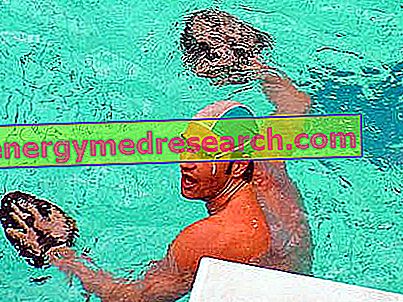Introduction
Washable diapers are reusable diapers several times, since they are made with fabrics and materials that can be machine washed.

At a time when many consumers are becoming more sensitive to environmental issues, the use of washable diapers seems to be expanding. In truth, to increase the use of this type of diaper there is also the economic savings that can result for new mothers and new dads who, with the birth of a baby, are already facing numerous expenses.
However, while on one hand washable diapers seem to be particularly advantageous, on the other there are parents who prefer to use disposable ones for greater ease of use.
However, during the article, the characteristics, types, advantages and disadvantages of washable diapers will be analyzed in detail.
Did you know that ...
According to some estimates, every child, during the first three years of life, consumes something like 6, 000 diapers that, to decompose, need approximately 200 to 500 years. Therefore, disposable diapers inevitably end up in non-recyclable waste, thus producing a certain environmental impact and generating a considerable cost for the parents.
What are
What are Washable Diapers?
Washable diapers are nappies that can be washed, by hand or in a washing machine, and then used several times.
Their use seems to have undergone an increase in recent years, probably both because of the eco-sustainability these products seem to have, and because of the potential savings in terms of money that can derive from them (more detailed information will be provided in the course of the article).
Did you know that ...
The invention of washable diapers is certainly not modern. At one time, in fact, before the advent of disposable diapers, diapers consisted of a square or a rectangle of cloth (generally linen or cotton), which was folded, then wrapped around the child and stopped with the classic brooches nurse (these are diapers "of the past" commonly known as ciripà).
The first washable diaper, in some sense the founder of the diapers that we currently define as such, dates back to 1950.
Features
Features of Washable Diapers
Although there are many types of washable diapers (from the classic square of cloth, up to the pre-formed diaper), they all have, of course, the characteristic of being washable, therefore, reusable over and over again.

Washable diapers can be manufactured with natural fabrics (cotton, gauze, bamboo fiber, etc.), with absorbent synthetic fabrics (for example, microfibre) and / or with waterproof fabrics, depending on the type of product taken into consideration.
Clearly, as with the classic disposable diapers, even washable diapers are available in different sizes and sizes, from those for newborns to a few days, up to the larger or one-size ones that can be used as long as the child he will not start using the potty or the classic sanitary vase.
Types
Types of Washable Diapers
As mentioned, there are numerous types of washable diapers that vary in shape, size and manufacturing materials.

The types and characteristics of the main washable diapers currently available on the market and mostly used will be briefly reported below.
Washable Foldable Diapers
Foldable diapers are diapers that must be folded manually to be worn by the baby. They are generally made of natural fabrics - present in one or more layers, depending on the model - and not waterproof . Clearly they require a certain dexterity in the execution of folds that is acquired over time and practice, but they have the great advantage of being able to be easily adapted to babies of all types, with different weights and sizes.
Among the main types of washable diapers of this type, we recall:
- Flat diapers (ie plates): they are washable, foldable diapers made up of a single layer of absorbent fabric, generally cotton or muslin (in English muslin, a fabric similar to dressing gauze), but it is also possible to find them in sponge. Washable diapers flats have a square or rectangular shape and vary in size.
- Prefolds diapers : they are nappies folded several times and sewn together so as to be made up of several layers of absorbent fabric . The layers are present in greater quantities in the central part than the lateral parts. They are rectangular in shape and, compared to the aforementioned flats, they guarantee a greater absorbency due to the multi-layer.
Fitted Washable Diapers
The fitted diapers are washable adherent diapers made of totally absorbent material (therefore, they are not waterproof ) and with an hourglass shape . They have an elastic part at the point where the child's legs will be, in order to guarantee a lower risk of spills. Some diapers of this type also have a velcro closure, while others must be closed with special clips.
Washable Pocket Diapers
Washable pocket diapers - or " pocket " diapers - are hourglass-shaped diapers with buttons or Velcro fasteners. They consist of an outer layer of waterproof material and an inner layer of absorbent or breathable fabric. These two layers are sewn together only on three sides, so as to leave an opening that provides access to the inner pocket that is created with the same seam of the two fabrics. Inside the pocket are placed absorbent inserts, generally made of bamboo fiber or microfibre .
A variant of pocket diapers is represented by the "sleeve" diaper, in which the outer and inner fabric are sewn only on two sides, allowing access to the inside pocket both from the front of the diaper and from the back.
All-In-One Washable Diapers
All-In-One (or AIO ) diapers are washable diapers consisting of a single block that has an external waterproof fabric sewn to an absorbent inner fabric . In some of them, a layer of breathable fabric is also sewn inside. They have a closure that can be with buttons or velcro.
All-In-Two Washable Diapers
All-In-Two (or AI2 ) diapers are washable diapers made up of two divisible parts.

More in detail, they consist of an external waterproof fabric, equipped with fixing elements, and a removable internal absorbent insert . The latter can have a rectangular or hourglass shape. The insert must be replaced when dirty, while the outside of the diaper can be reused for the whole day.
Accessories for Washable Diapers
The washable folding diapers and the fitted usually require the use of additional accessories, such as:
- Cover : the covers represent a waterproof cover to be applied over the washable diapers that do not have it (such as folding or fitted). It is made, in fact, in waterproof fabric and is equipped with closing buttons.
- Diaper clips : they are special clips to be used to close and maintain foldable diapers and fitted without the appropriate closure.
Did you know that ...
Although there are different types, it is also possible to "invent" combinations of washable diapers until you find the ideal product for your child's needs, or to be able to use diapers that can be washed in several ways. For example, in diapers with the waterproof outer portion not sewn to the absorbent part, instead of the fabric inserts with which they are supplied, it is possible to use - properly folded - the foldable diapers in natural fabric (for example, a prefold folded in three can quietly acting as an absorbent insert in a diaper AI2).
Tips for Use and Care
The way of use, or rather, the way in which the diapers must be put on the child depends substantially on the type of diaper that you decide to use.
Pocket diapers, all-in-ones and all-in-two are probably easier to use, as they are similar to disposable diapers, but may not be suitable for all newborns.
For those who are inexperienced, but want or need to resort to the use of washable folding diapers, it is advisable to refer - where present - to the instructions on the package, or possibly to ask for more detailed information from the dealer or those who already have experience with this type of diaper . In fact, to make the baby wear the diaper correctly and to make it leak-proof, it is necessary to acquire a certain manual ability in the folding of the same. In any case, the web is full of tutorials and detailed instructions on how to fold washable diapers.
Useful Tips for Buying and Using Washable Diapers
Clearly, since the diapers will have to be washed, it is necessary to buy them in a suitable quantity. Ideally, 20-25 washable diapers should be sufficient, however, the exact number may vary depending on the needs of each parent and each child. Naturally, for the first days of life of the newborn it will be necessary to buy small diapers, while in later periods it is possible to use one-size washable diapers, equipped with adjustable closure that can adapt to the child's gradual growth.
However, regardless of the type of washable diaper that you intend to use, it is always good:
- Be sure to use baby-sized washable diapers;
- In order to prevent spills, always check the girocoscia to make sure that the diaper is correctly positioned and is firmly attached;
- Be sure to close the diaper properly, so as to avoid accidental opening and subsequent leakage.
Washing Tips
Washing washable diapers is extremely important. In fact - in addition to ensuring the correct degree of cleaning and, above all, hygiene - the washing method also affects the total annual cost and the environmental impact of the diapers in question.
- For the first use, if the fabric with which they are manufactured allows it, washable diapers must be washed at 60-90 ° C ; subsequently, the washing temperatures can be decreased, unless it is necessary to continue to use high temperatures (for example, if the child suffers from particular irritations or infections).
- To ensure an optimal seal, the external panty made of waterproof material with some washable diapers, as well as any waterproof cover should not be washed at temperatures above 60 ° C.
- For the safety of the child and to avoid unpleasant irritation, try to avoid bleaching and the use of detergents or additives containing chlorine or other bleaching substances . Likewise, avoid the use of fabric softeners that could cause discomfort to the delicate skin of the newborn. Furthermore, avoiding the use of this type of cleaning products can be useful to ensure greater durability of washable diapers, better sealing, impermeability and absorbency and a lower environmental impact.
- After washing, carry out a thorough and thorough rinsing .
- While waiting for washing, diapers and absorbent inserts should be cleaned of any faeces and left in a special bin or container.
Please note
Of course, those reported so far are recommendations and not obligations. In fact, each parent can manage washable diapers as they see fit, depending on their needs and those of their child.
Advantages and disadvantages
Advantages and Disadvantages of the Use of Washable Diapers
Below are the main advantages and disadvantages of washable diapers. Clearly, each parent can have their own preferences, just as each child may need a particular model or type of diaper (washable or disposable) rather than another. Therefore, sometimes, the advantages and disadvantages could be subjective.
Advantages
Among the main advantages of washable diapers we find:
- The possibility of re-use that allows to produce less waste and less impact on the environment.
- If used appropriately and purchased wisely, washable diapers allow parents to save money .
- Being generally manufactured with natural fabrics, it is probable (but not assured) that the risk of dermatitis or diaper irritation is reduced by the use of a washable diaper. However, this aspect is very subjective and varies from child to child.
- Unlike the disposable ones that guarantee a "dry effect", washable diapers provide the newborn and then the baby with a greater perception of urine and faeces. This perception, considered by many to be a disadvantage, can instead be an advantage when the child has to stop wearing the diaper to learn the use of the potty or the real vase. Even in this case, however, there is a certain degree of subjectivity.
Disadvantages
The main disadvantages of washable diapers can be the following:
- For the less experienced, it can be difficult to identify the type of diaper that best suits your child.
- Washable folding diapers can be difficult to put on, precisely because you need to master the folding techniques. A wrong turn, in fact, can cause the diaper does not adhere well, making the risk of leakage real and effective, especially during the first periods, when the baby's feces are definitely liquid.
- They may be impractical to use, in particular when traveling, as it is necessary to bring with them nappies and / or dirty absorbent inserts.
- The diapers in question need to be washed, so they need a drying time that can vary depending on the type of fabric they are made of.
Washable diapers: more or less breathable than disposable?
The debate concerning the breathability of washable diapers is the subject of much discussion. If on one hand, supporters of the washable diaper assert that the baby's skin can transpire better, on the other they are in different to deny this belief.
Since many washable diapers are made with natural fibers, they could effectively guarantee better breathability, avoiding the increase in local temperature that can occur with disposable diapers. On the other hand, it is true that the breathability is maintained only if the washable diapers are not equipped or added (cover) with a layer of waterproof material to avoid soiling the clothes. Otherwise, breathability is inevitably reduced by waterproofing.
Ecosustainable Choice and Economic Advantage?
Many parents choose to resort to the use of washable diapers believing that they are making an eco-sustainable choice that, in addition to "safeguarding" the environment, should also ensure a certain economic saving. But is it really so? Let's analyze the question in more detail.

Sustainability
Undoubtedly, the use of washable diapers helps to reduce the environmental impact from the point of view of the quantity of waste produced, but in order to reach high levels of eco-sustainability, special attention must be paid to the way these diapers are washed. In detail, to reduce the environmental impact deriving from the washing of the diapers in question, if and when possible, it would be good:
- Wash diapers at low temperatures.
- Wash diapers together with other garments so as to start the washing machine ONLY at full load.
- Do not overdo the amount of detergent, using only the required amount.
- Avoid using the dryer.
Economic saving
According to tests carried out by magazines in the sector, the use of washable diapers would, in fact, lead to some savings in the pockets of new parents.
According to the theoretical calculations carried out, the annual expenditure for the purchase of the classic disposable diapers would vary from about 400 euros for disposable diapers at a better price, up to over 800 euros for disposable diapers of higher quality .
On the contrary, the annual cost for washable diapers - calculated by including the purchase of about twenty diapers complete with everything (external part in waterproof fabric, absorbent inner part, etc.) and the expense deriving from their washing (electricity, water, detergent, etc.) - would be around around 200-300 euros .
Therefore, washable diapers can actually lead to a certain saving, as long as they are bought in an informed manner and as long as you pay attention to the way in which they are washed.



